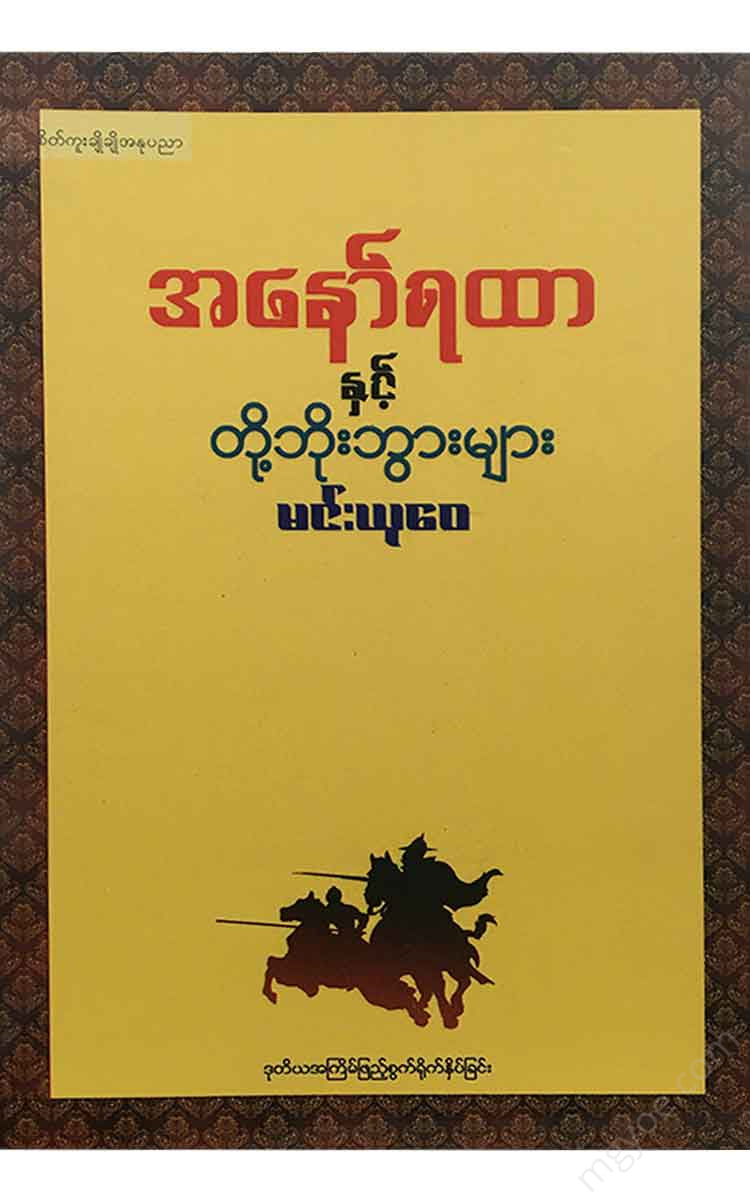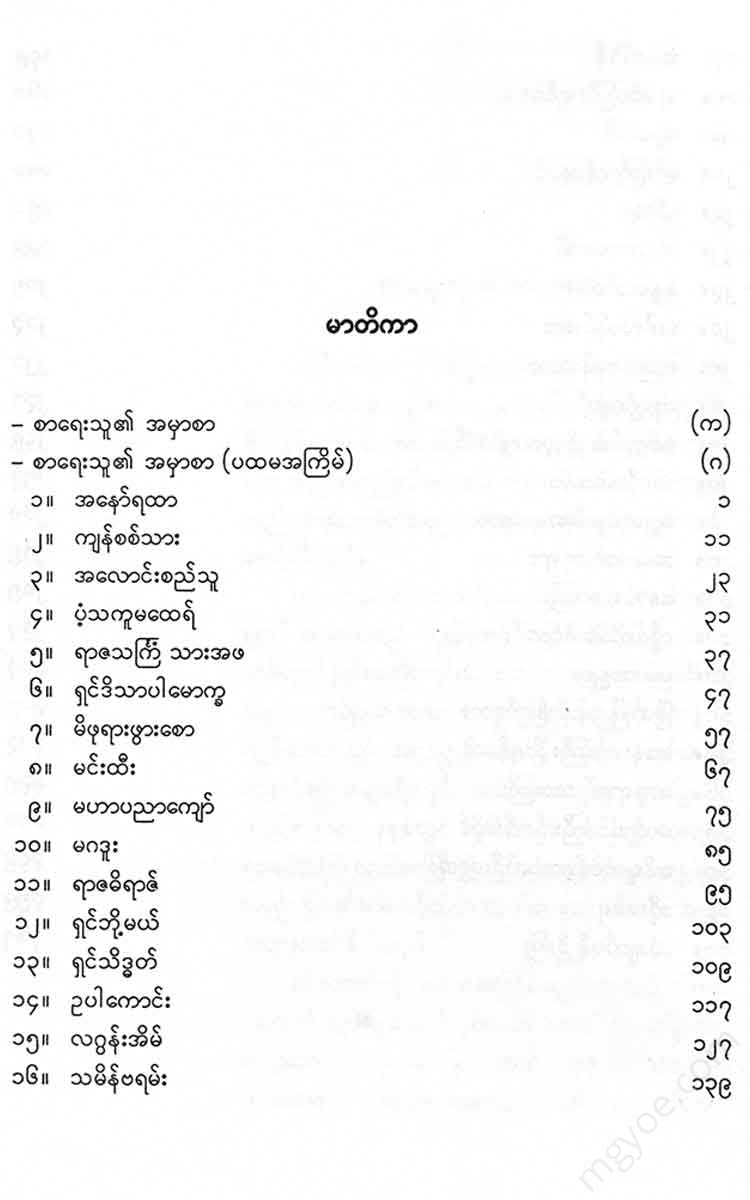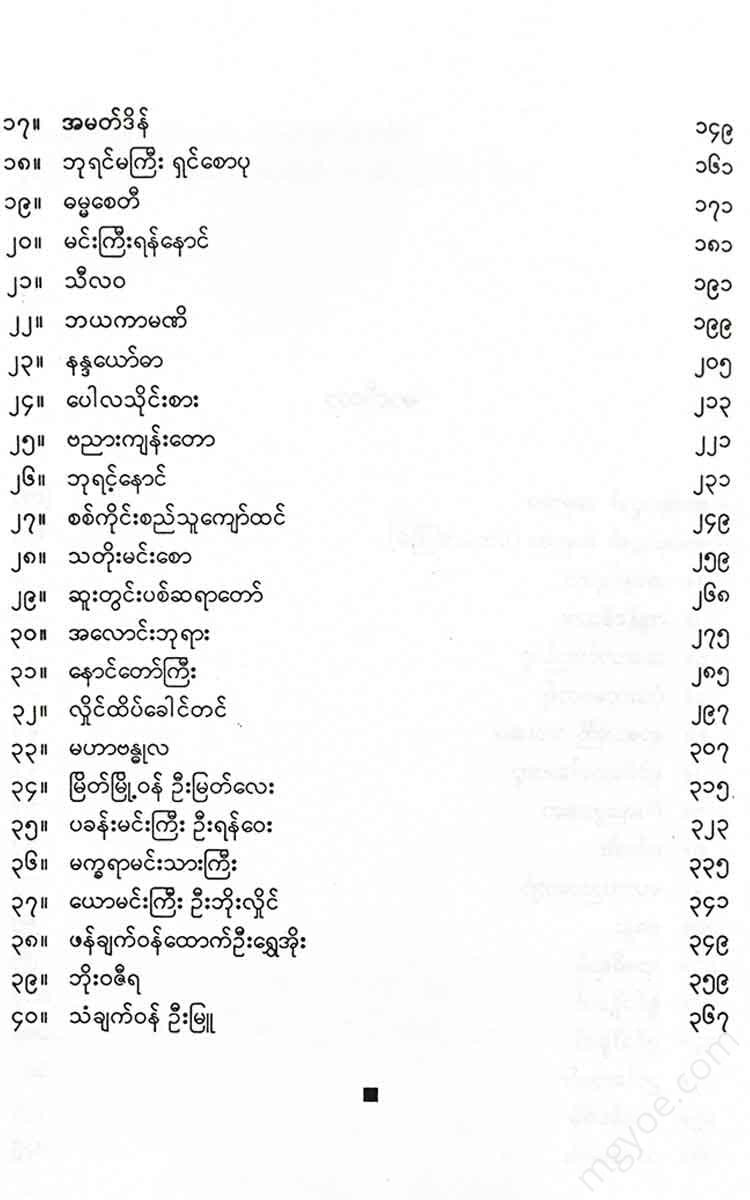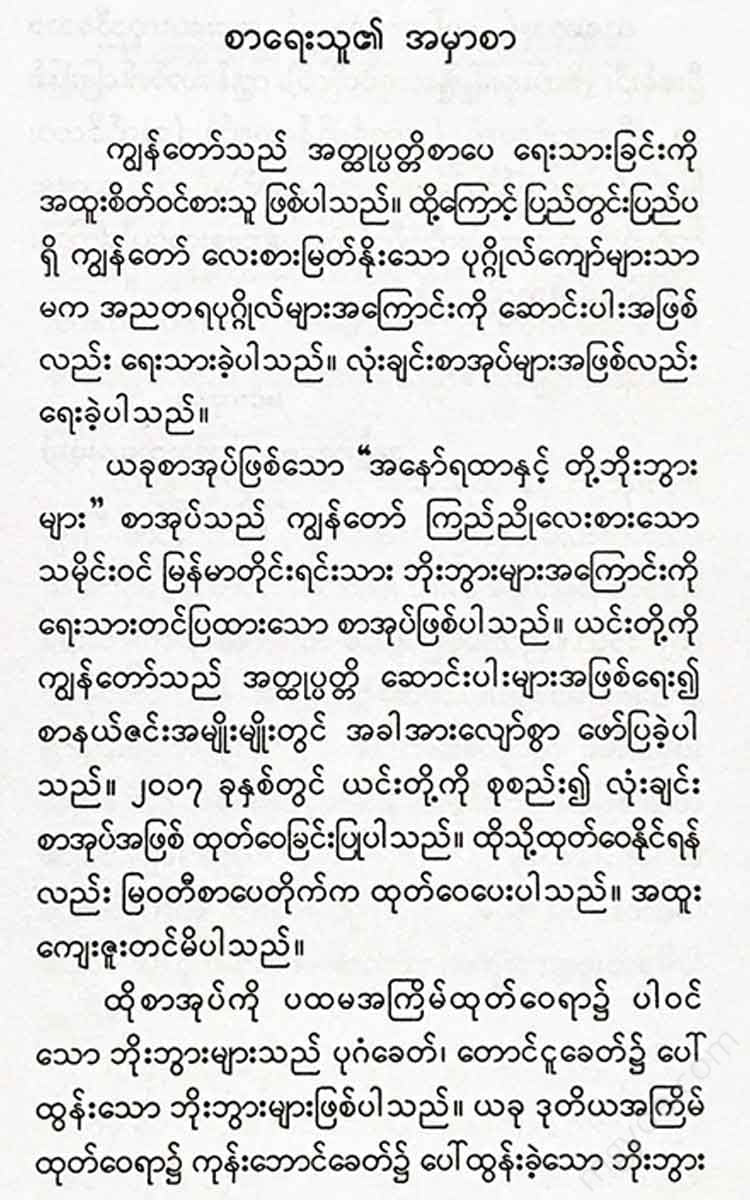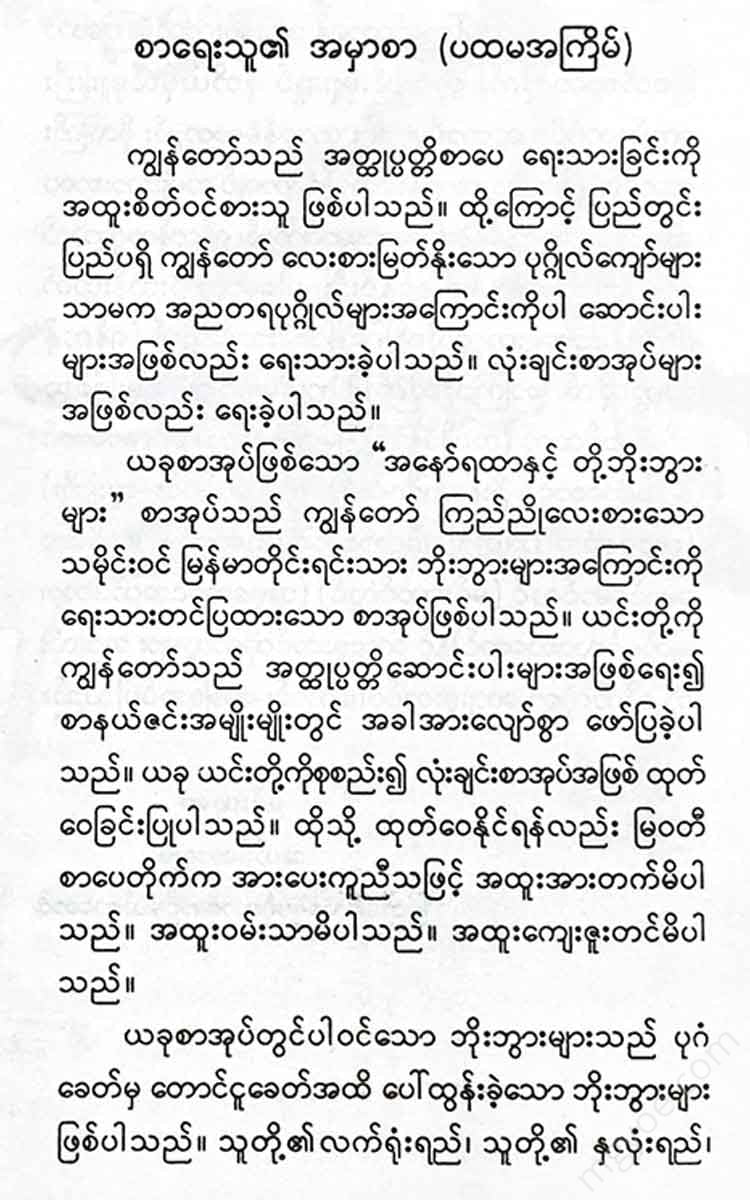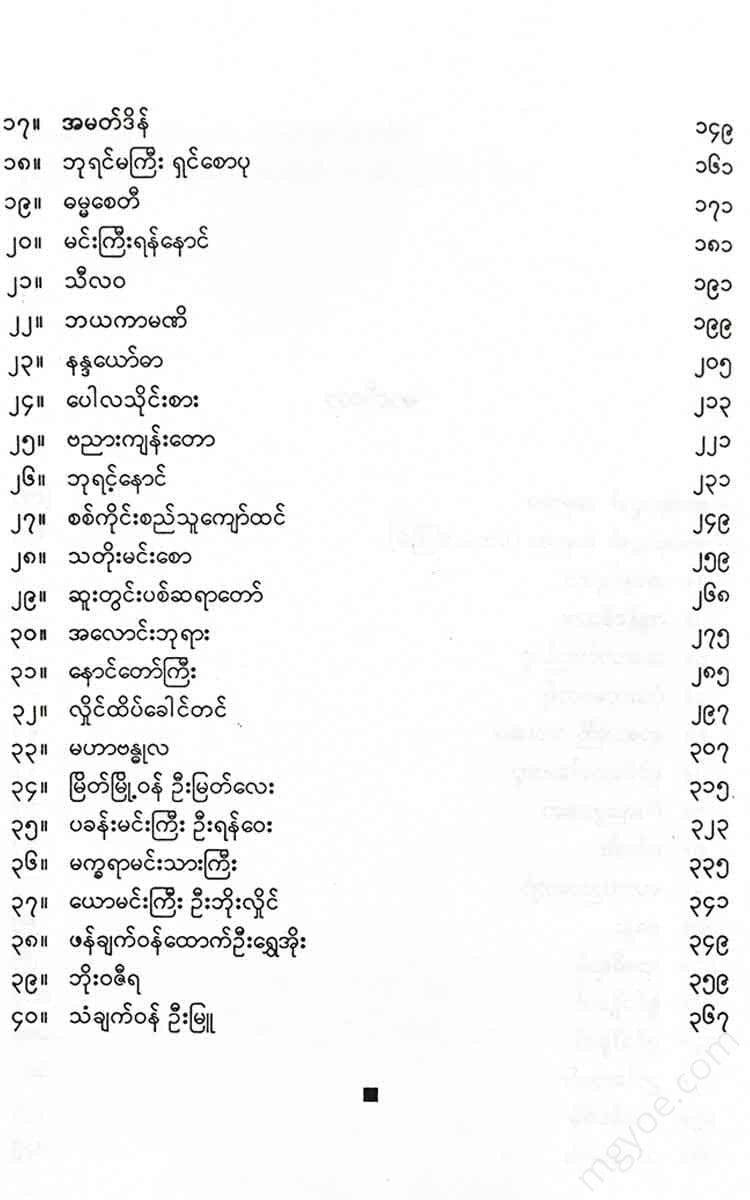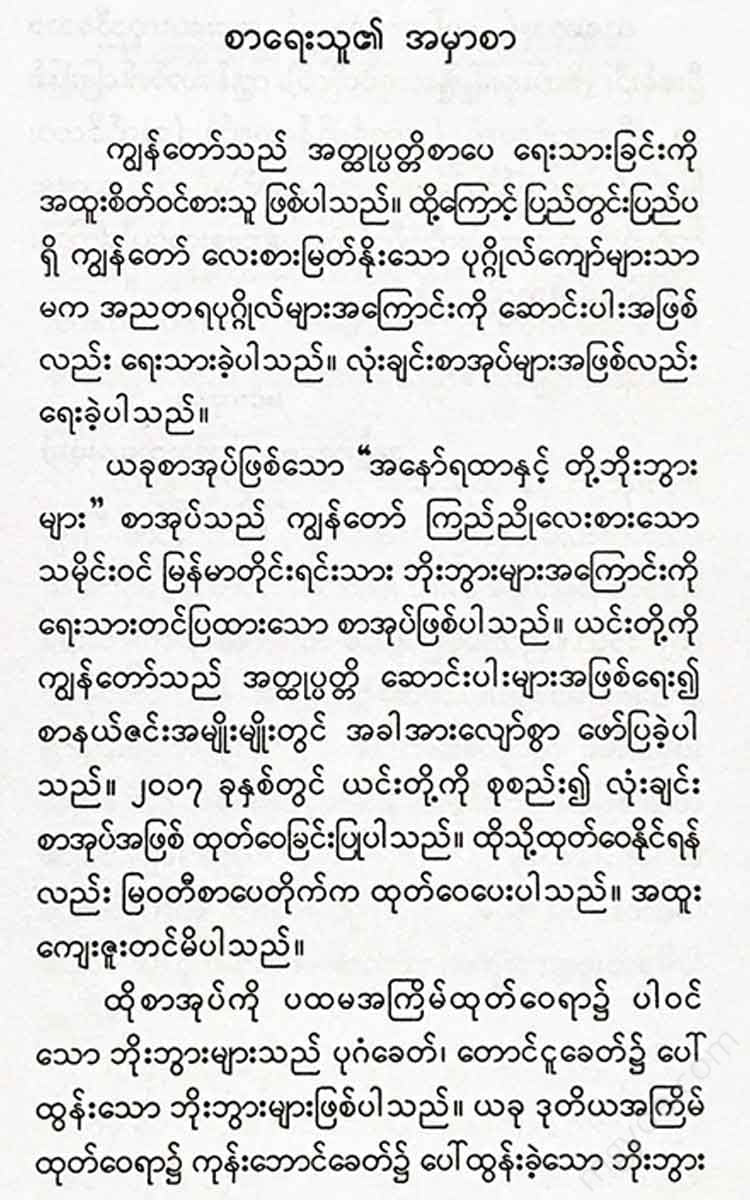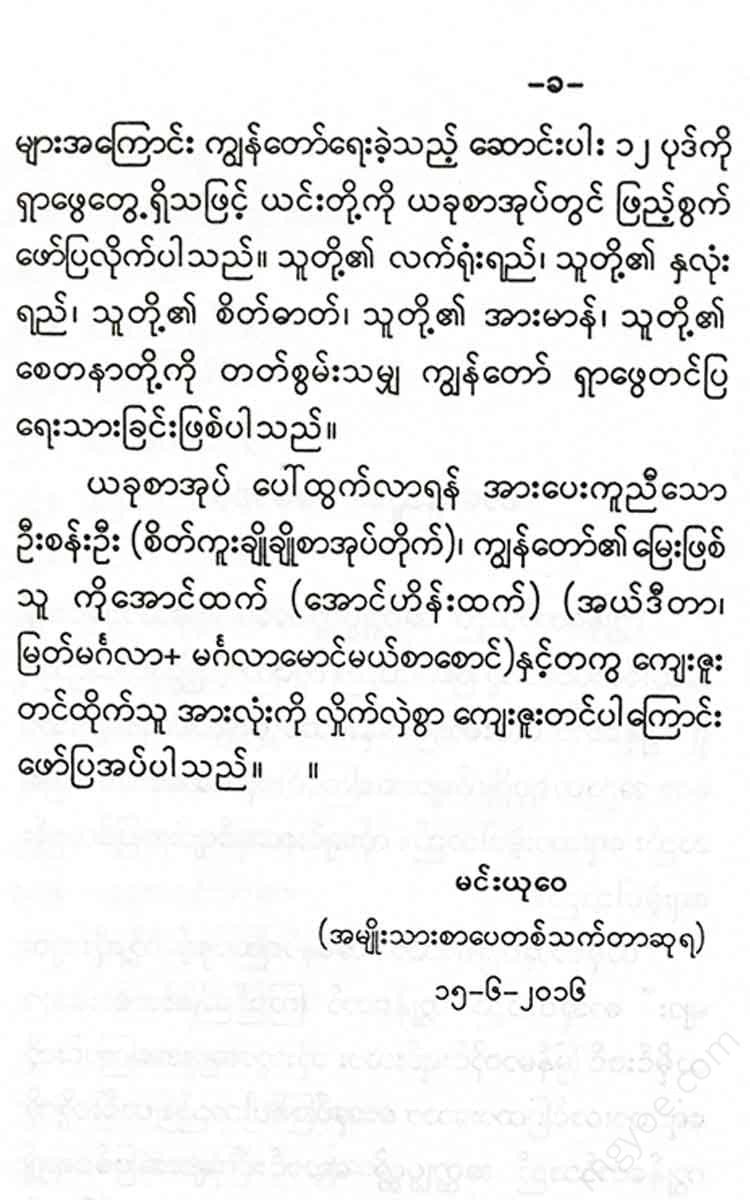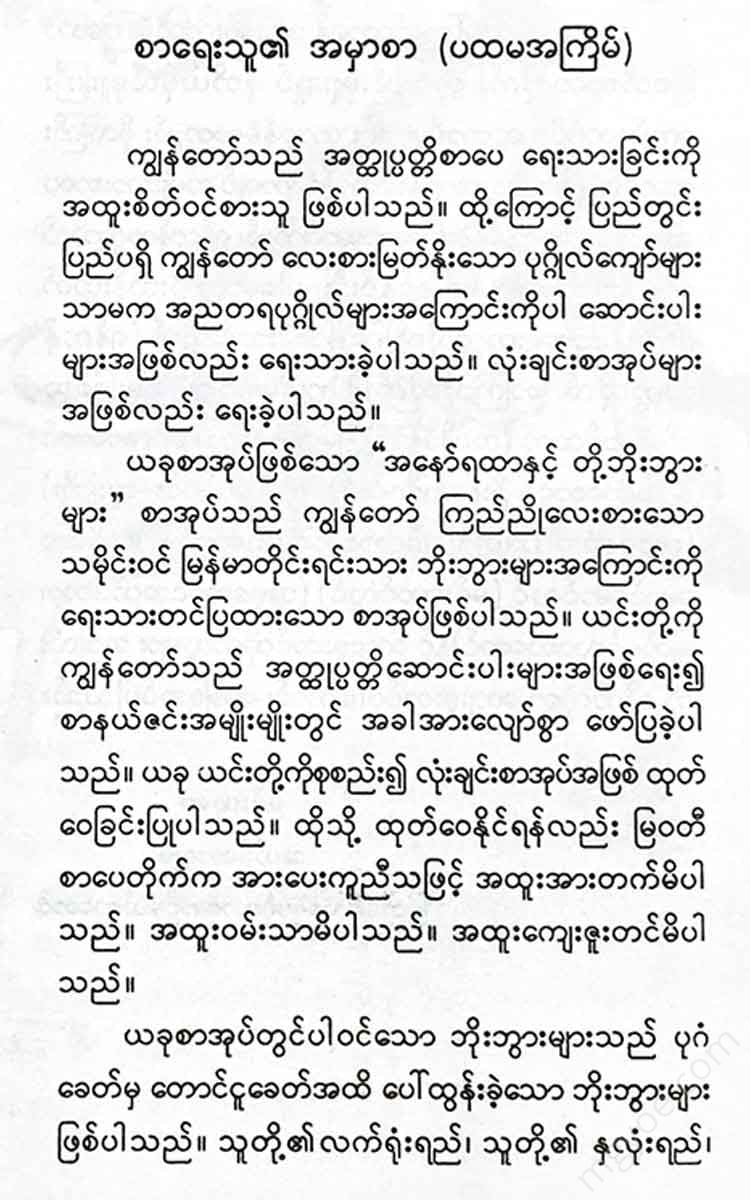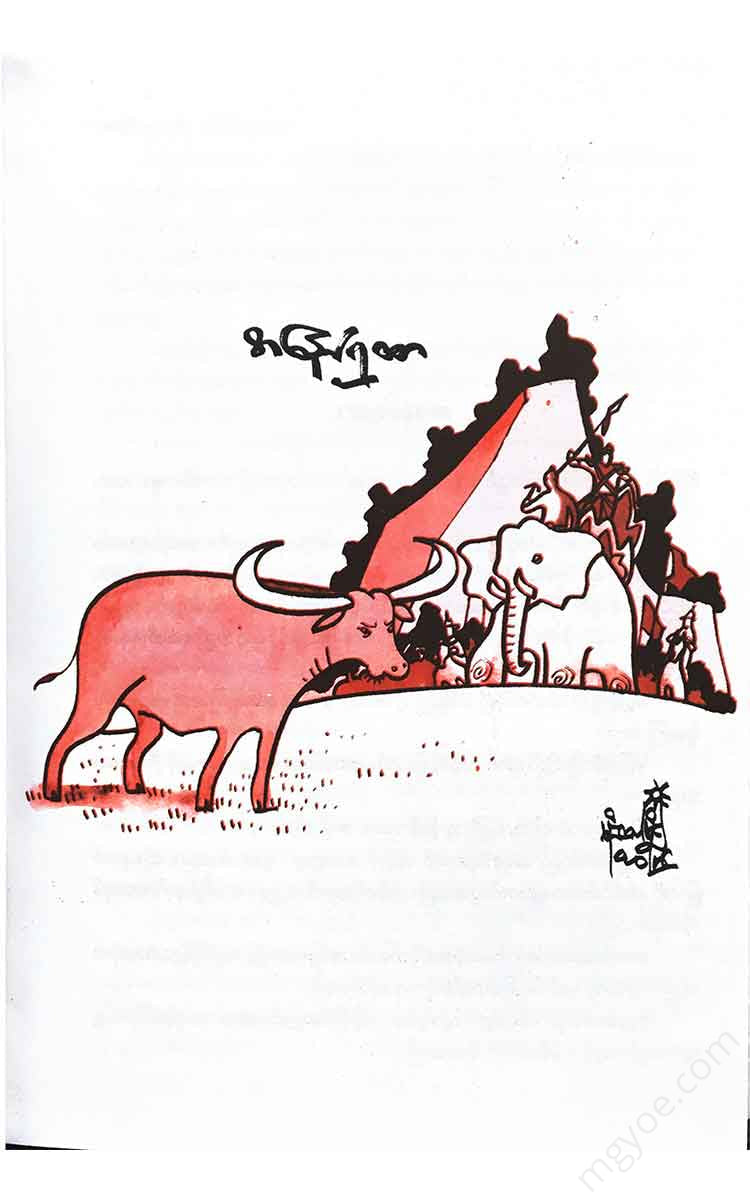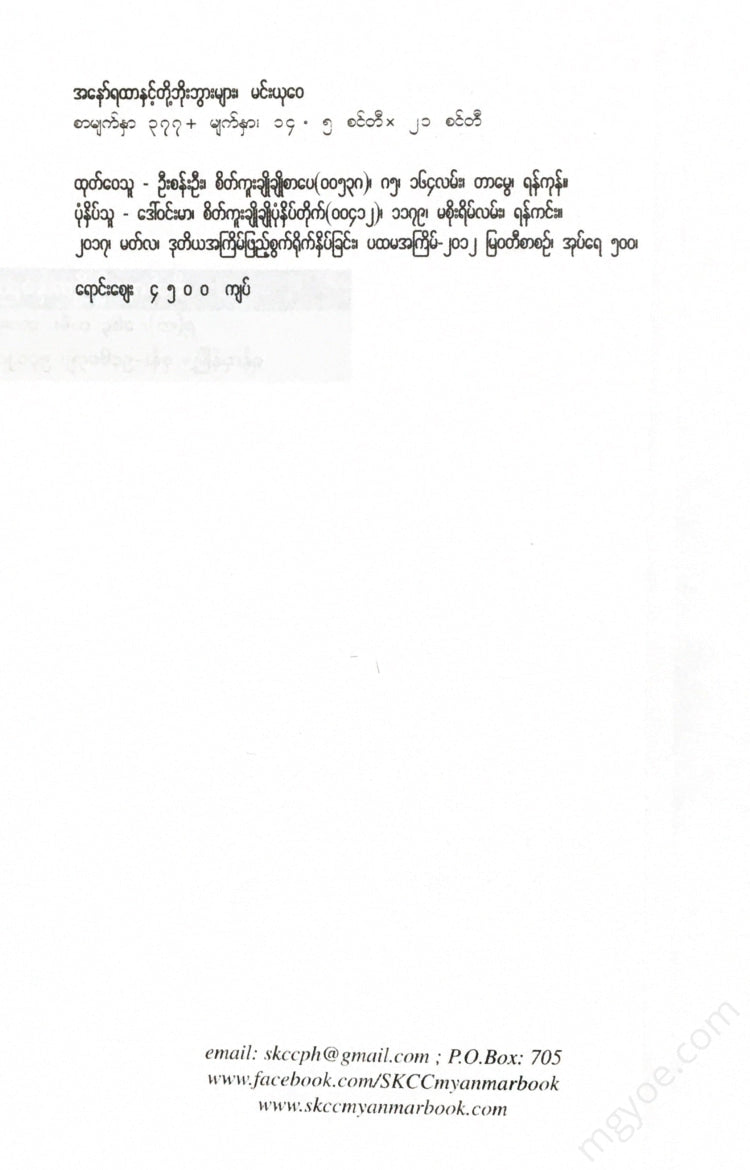စိတ်ကူးချိုချိုစာပေ
Min Yu Wa - Anawrahta and his ancestors
Min Yu Wa - Anawrahta and his ancestors
Couldn't load pickup availability
Anawrahta
When the appointed day arrived, Sukkate and Anawrahta met by the Thamahti Stream.
Sukkate was the king of Bagan. Anawrahta's cousin. Anawrahta was the son of the deposed king of Bagan, Kwansaw. Sukkate's cousin. The two of them were about to fight on horseback. This was no ordinary battle. It was a battle to the death. Moreover, the winner would also rule the Bagan throne.
Therefore, all the people of Bagan are interested in that battle. They are very excited.
Soon they were siblings. Anawrahta preferred Sukkate.
"Your brother is older than me. Strike first."
Sukkatae aimed his spear at Anawrahta carefully. Then, riding his horse, he approached. As soon as he got close, he struck with all his might.
Anawrahta quickly defended himself with the Arindam spear his father had given him. It did not hit him, but only the horse's head.
When Sukkata saw that his spear had missed, he was very afraid. He was trembling.
Meanwhile, Anawrahta did not hesitate. He rode his horse towards Sukkate. As soon as he got close, he skillfully threw his Arindam spear. Sukkate could not defend himself. He could not dodge. He hit him in the chest. The spear came out from behind Sukkate's body. Sukkate did not immediately fall to the ground. He was carried on his horse's back until he reached the stream, where he died.
The battle was as terrifying as it was historic. What was the reason for this battle?
The 39th King of Bagan, Kwansaw (Kyung Phyu Min), ascended the throne of Bagan in 964 AD. At that time, he appointed three sisters, Taung Pyin, Ae La Pyin, and Maw Kyaw Pyin, as his queens. These three sisters and queens were the queens of the deceased King Taung Thu Min (Nyaung U Saw Rahan). When Kwansaw ascended the throne, he continued to appoint these queens as his queens. At that time, his elder sister Taung Pyin was pregnant with Kya Soe, who was born to Taung Thu Min, for nine months. His younger sister, Ae La Pyin, was pregnant with Sukketay, for six months. Only his younger sister, Maw Kyaw Pyin, did not become pregnant. It was only when Kwansaw and Ae La Pyin were reconciled that Maw Kyaw Pyin gave birth to Anawrahta.
Although Kyi Soe and Sukkate were the sons of the Taungthi King, Kwansao did not fight them or insult them. He raised them well, just like his own son Anawrahta.
However, Kyi Soe and Sukkatay did not accept Kwansao's favor. They plotted to seize the throne of Bagan.
After 22 years of reigning as King Kwansao, the brothers Kyi Soe and Sukkate put their plan into action. They built a beautiful temple on the outskirts of Bagan. Then they tricked King Kwansao by saying, “Father, please bring alms for the donation of the temple.”
King Kwansaw followed him without questioning or thinking, but with faith. Meanwhile, the conspirators captured King Kwansaw, threatened him, and forced him to become a monk. They spread a false rumor among the people of Bagan, saying, “My father, King Kwansaw, has become a monk because he has heard the Dhamma.”
Then Kyi Soe came and seized the Bagan throne. Then Anawrahta and Mae Taung Myaw Pyin moved to live in the monastery where the monks were monks. Anawrahta went from being a king's son to being a king's son, and lived a miserable life.
Kyi Soe ruled for six years and died. He became King Sukkate. Anawrahta also served King Sukkate and served him. One day, while he was serving, Sukkate called Anawrahta “My brother-in-law, my son.” Now they were cousins. If he captured Anawrahta’s mother, he would have a son. That is why he said “My brother-in-law, my son.”
Anawrahta did not understand that. He spoke to his father, who was a monk. Then his father explained, “I want to take your mother and call her ‘younger sister’.”
Anawrahta was furious. Sukkate had deposed his father. Now he would take over his mother. In fact, his mother was Sukkate's stepmother. Sukkate was wicked. He could not bear it anymore and decided to attack Sukkate. He asked his father for a spear, a sword, etc. His father gave him the weapons. "Go to the place of Amaung Poppa and gather your men first. Then attack."
Anawrahta also went to Poppa as his father had ordered. The force was strong. Meanwhile, Sukkate captured Anawrahta's mother, the North Pyin.
As soon as Anawrahta had gathered strength, he marched on Bagan. He sent a message to King Sukkata, asking, "Will you give me the throne or will you wage war?"
Sukkata was also furious. "You have not even tasted milk in your mouth, yet you dare to fight me. Can you defeat me? I do not want you to defeat me with a horse and a lion. Let the nobles and generals watch. You and I will fight each other on horseback," he said.
Thus, Anawrahta fought with Sukkate on horseback and won.
When Sukkatay fell, Anawrahta, accompanied by his nobles and generals, went to his father. He begged, “Father, please be king.” | His father refused.
"I am old, my brother, please rule according to the law," he said.
From there, Anawrahta ruled the kingdom of Bagan. He also ordained his father as a monk. Anawrahta took the title “Maharajasiri Aniruddha Deva”. Some also call him “Aniruddha”. Anawrahta was the 42nd king of Bagan. He ruled the country for thirty-three years from 1044 to 1077 AD. During those thirty-three years, he worked to develop, expand, organize, make the country prosperous, and enrich it. He worked to promote Theravada Buddhism and promote culture.
The mainstay of the economy in the country is agriculture. Water is also essential for the success of agriculture. Therefore, Anawrahta Min improved the Meiktila Lake. In the arid regions, dams, canals, lakes, and streams were built.
He traveled around the country and when he reached the Kyaukse area, he climbed the Thalyaung mountain. Then he saw water falling from the top of Kayut mountain.
“If the water is dammed and cultivated, all beings will prosper for five thousand generations.” He thought. Thus, on the Panlaung River, Kinta Dam, Nga Nai Thin Dam, Mai Pyo Dam, and Ku Me Dam were to be dammed. On the Zawgyi (Makkha) River, Na Taet Dam, Kuan Say Dam, and Kutaw Dam were to be dammed. In addition, he also developed 11 villages in the fields.
The 11 fields are the sea, the river, the river, the horse-drawn carriage, the river (Ron), the river (Pan), the mountain (Pan), the mountain (Mekhra), the mountain (Tapya), the mountain (Tintaung), the mountain (Tamose), and the mountain (Kollu). These are also called the 11 villages of the river. They are also called the 11 districts of the river.
King Anawrahta also appointed dam guards and dam keepers to maintain the dams for a long time. Under the dam guards and dam keepers, dam workers called pinthar were also appointed. They maintained and repaired the dams to prevent damage. The fields that used irrigation water were called irrigated fields. The irrigated farmers paid taxes for the maintenance of the dams. Sometimes, when there was an urgent need to repair the dams, these farmers had to work together with the dam guards, dam keepers, and pinthar.
In this way, the people of Bagan cultivate fields, orchards, gardens, and so on. They plant various crops such as rice according to the season to produce abundant crops.
With success, they had an abundance of food, drink, and sweets. The economy was very good.
King Anawrahta was not only full of wisdom but also full of courage. He loved and honored heroes who were as capable as he was. Among them, Kyan Sittha, Nga Twe Ru, Nga Lone Lek Phae, Nyaung Oo Phi, etc. were the most prominent. Kyan Sittha was not only full of strength but also of heart.
Anawrahta appointed them as chiefs, ministers, and generals, and formed a strong, diverse, and multi-ethnic Bagan army. In forming the army, the strength of the soldiers was proportional to the strength of the subordinate shahs, cities, and districts. When faced with an emergency, they were called upon. With that strength, he conquered the scattered territories.
At the beginning of Anawrahta's reign, the area of Bagan was only around the central part of Myanmar. Thanks to Anawrahta's efforts, he was soon able to unite many areas. He was able to conquer not only lower Myanmar, but also the areas around Thaton, Tanintharyi, Rakhine, Bhamo, and Myitkyina. Anawrahta's soldiers, led by Kyan Sitthar, successfully repelled the Jwam warriors who attacked Utsagae. (Jwam warriors were ancient Khmers who believed in Shiva Hinduism from the country that is now Kampuchea.)
Anawrahta successfully demonstrated his military might by capturing the northern states of Thetkadu (Kanbu) and preventing the threat of the Nan Saw. He also established 43 fortified cities to protect them from the Nan Saw and other foreign enemies.
Thus, the first organized and strong "First Myanmar State" was established during Anawrahta's reign. All ethnic groups enthusiastically accepted Anawrahta's leadership and actively participated in nation-building.
In addition to these, King Anawrahta also promoted Theravada Buddhism and pure culture. Through this religion and culture, he also worked to achieve unity among the upper and lower classes of the country.
In Bagan, there were Theravada sects, Mahayana sects, Vishnu sects, Naga sects, Gavanpati sects, etc., which had flourished since the ancient Pyu period. The great sages who practiced a certain form of Tantric sect were also very influential.
The monks reject the teachings of the Buddha. They each take their own ideas. They make scriptures according to their own desires and deceive people. If a person who kills his own life recites this mantra, he is free from sin. If a person who kills his parents recites that mantra, he is free from sin. If he does any evil, he must confess his sins and ask the monks for forgiveness. If the monks allow him, he can escape from hell and go to heaven. Furthermore, when the children of kings, chiefs, ministers, clans, nobles, rich people, and the common people are married, they are sent to the monks at night. When the sun rises, they are sent back. If the couple gets married without sending the mantra to the monks, they are considered to be breaking the tradition.
Anawrahta did not like these actions. At that time, the Mon monk Arahant Thera, who was called Dhammadassi, came to Bagan from Thaton. He preached Theravada Buddhism to Anawrahta.
When King Anawrahta heard this, he was delighted and delighted. His faith became even stronger than before.
"For the disciple, there is no other god but the Lord. From this day forward, I entrust my body and life to the Lord. The disciple will also receive the Lord's teachings."
Then he built a beautiful temple in a place where the forest could be built. He worshipped the Buddha. He listened to his teachings. King Anawrahta himself carried water, his queen served him alms, and he continued to do good deeds every day. He also rejected the beliefs of the great sages. He also made all the people reject them.
The chieftains were not happy with their wealth and were very hostile to the king. The king was worried and ordered the chieftains to be guarded. He dressed thirty chieftains and sixty thousand disciples in human clothes. He gave them spears, elephant dung, and horse dung. .
The arahant preached the Theravada Buddhist teachings to the people. He ordained those who believed in the teachings as monks.
According to the instructions of the arahant, King Anawrahta learned that King Manuha (Makuta) of Thaton had 30 sets of the Pitakas. He sent a wise minister to Thaton. He asked for the Pitakas. Manuha did not give him the Pitakas. He spoke rashly and said things that were not true. King Anawrahta marched against Thaton with a large army in 1057. He brought 30 sets of the Pitakas. With King Manuha
